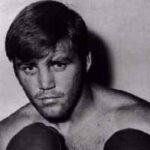“They said I was the fighter who got knocked down the most, but I also got up the most.”
Floyd Patterson
The singular moment that defined Floyd Patterson both as a boxer and a man came immediately after his rematch with Ingemar Johansson of Sweden. Patterson had avenged his crushing knockout defeat at the hands of “Ingo,” making history by becoming the first man to ever recapture the crown and become a two-time heavyweight champion. But Patterson did not dance a jig, do a flip, climb the corner ropes and bang his chest, or even pump his fist in the air like so many others would have. Instead, he gently helped Johansson back to his corner and offered him a rematch. Although Patterson established records made boxing history, he is remembered first and foremost as the sport’s great heavyweight gentleman.
The Last of an Era
Floyd Patterson was born January 4th, 1935, one of 11 children in a poor North Carolina family. After moving to Brooklyn as a boy, Patterson was getting himself into petty street trouble, skipping school and stealing. He was sent to reform school, which turned his life around. He took up boxing after that, and was schooled by the great trainer Cus D’Amato (D’Amato would later serve as Mike Tyson’s first trainer). At 17, Patterson went to the 1952 Helsinki Olympics and won the Gold Medal as a middleweight. Rounding out his stellar amateur career, Patterson also won the 1952 National Amateur Athletic Union and the New York City Golden Gloves middleweight titles that same year. He turned pro in September, weighing in at 164.5 lbs for his first bout.
Patterson began his career as a middleweight and light heavyweight, and in many ways he was the last old-style heavyweight. For the first half of the 20th Century, the “big men” had not been so big by modern standards. Patterson stood 6 feet tall and weighed in at above 200lbs only once in his entire career; typically he weighed in between 185-190lbs. Today, Patterson would be campaigning as a light heavyweight or cruiserweight, but he actually was very typical of the heavyweight tradition as it stood at the time. Rocky Marciano was roughly the same size as Patterson; Ezzard Charles and Joe Walcott were only a little bigger. He was the last champion from the time when the phrase “heavyweight champion” routinely referred to men over six feet and 210lbs.
As a boxer, Patterson had a suspect chin and developed a “peek-a-boo” style of fighting, employing a high, tight guard (Tyson, although not lacking in the chin department, later employed the same “peek-a-boo” guard). Even though most heavyweights of the day weren’t substantially taller than Patterson, he still had a short reach, and developed a way of leaping in with his left hook to overcome that. It was a technique that has never been fully duplicated, perhaps because it is so dangerous: it generated power and overcame distance, but left him open to being caught in mid-flight and shot down with devastating effect. Only a truly skilled master craftsman of the sweet science could routinely throw such a shot and get away with it, but Patterson was exactly that. Muhammad Ali would later call him the most skilled boxer he ever fought, and given Ali’s career resume that is high praise indeed.
Getting Started
Patterson kept a busy schedule early in his career, racking up a streak of 13 wins until he met the great former light heavyweight champion Joey Maxim in 1954. It had only been two years since Maxim had beaten the legendary “Sugar” Ray Robinson, although he had since lost all three bouts in a trilogy with the almost as legendary “Old Mongoose” Archie Moore prior to meeting Patterson. Maxim still had too much for the young fighter, and defeated Patterson on points. Patterson went back to work, eventually moving up to heavyweight and racked up a 16 fight winning streak, culminating with his next big fight against Maxim’s nemesis Archie Moore in 1956 for the heavyweight title vacated by the retired Rocky Marciano. Patterson had dramatically improved as a fighter over the preceding two years, and demonstrated it by knocking out Moore in the 5th Round. He was 21 years old, the youngest man to win the heavyweight crown, and also the first Olympic Gold Medallist to do so.
Two-Time Champion
Patterson defended the title 3 times in 1957 and 1958. This included a rematch with Tommy Jackson and a thrilling, knockdown-laden encounter with undefeated Roy Harris, but also a scandalous bout with the 1956 Olympic champion Peter Rademacher. Rademacher was making his pro-debut, and had no business doing so by challenging Patterson for the world title. A fight like that came off because Patterson’s trainer Cus D’Amato was not just a great trainer; he was also a shrewd business man. Having guided his protégé to the top, he was now intent on making a mint off Patterson, not establishing him as a great champion. That meant dodging truly dangerous fighters who might upset the gravy train.
After flattening the unheralded Brian London, Patterson met Ingemar “Ingo” Johansson in 1959. “Ingo” was 21-0 at the time. Johansson was a limited fighter, but he was a strong, powerful man with a hard right hand. Although he rarely fought outside of Sweden, he had ominously knocked out British contender Henry Cooper in 5 rounds and American contender Eddie Machen in 1 round. Johannson knocked Patterson down 7 times en route to a crushing 3rd Round stoppage. Patterson was so humiliated he sunk into a deep depression and didn’t leave his house for a month. However, he eventually recovered and sought revenge. Bulking up from 182lbs to 190lbs (one suspects the added muscle had more to do with improving his confidence rather than his prowess), he met “Ingo” again a year later and did the impossible: he crushed the man who had overwhelmed him with his leaping left hook, knocking him out in the 5th Round and becoming the first man to ever win back the world heavyweight title. Johansson had been hit so hard he remained unconscious for five minutes. Ingemar Johansson and Floyd Patterson would meet a third and final time in 1961 to “break their tie.” Both men hit the canvas in the 1st Round, but it was Patterson who rallied to knock out the Swede in the 6th.
Demolished
Patterson rounded out 1961 by defending against the utterly overmatched, but undefeated Tom McNeeley. McNeeley was D’Amato’s “handpick,” and was knocked down 11 times on his way to a 4th Round stoppage. However, by now the clamor was rising for Patterson to meet the most menacing figure in heavyweight history, Sonny Liston. Liston had infamously gone to prison for armed robbery as a teenager, then again in the middle of his boxing career for beating up a police officer, and was linked with organized crime. Boxing fans accused Patterson of fighting handpicks and ducking the Liston, the #1 contender. However, there was also the legitimate hope on the part of many that Patterson the Sportsman would defeat Liston the thug. President Kennedy had encouraged Patterson to meet Liston, using civil rights leaders as intermediaries. If it had been left up to D’Amato, Patterson would have dodged Liston clear through to his retirement, but the champion was stung by the criticism and agreed to meet the #1 contender in September 1962.
If Patterson was the last of the old, small heavyweight champions, Liston was the first of the new breed of ever bigger men. Although both men stood six feet, Liston outweighed the champion by almost 25 pounds. Indeed, Liston’s career lowest weight – when he was still just a teenager – is the same as Patterson’s career highest. He was even stronger that Ingemar Johansson, armed with a thudding jab and awesome power, and an all-around technically sound fighter. It was a bad match for Patterson, who was demolished by Liston in one round. In 1963 Patterson and Liston met again, with exactly the same result. As with the Johansson loss, Patterson sunk into a deep depression. He was only 28 years old.
The Contender
Patterson eventually recovered from his depression and sought to become the first man to win the heavyweight title three times. Ironically, it was in this forlorn quest that Patterson went out and did what his critics maintained he never did as champion: he fought just about everybody he could get in the ring with him.
In 1964 and 1965, he fought five times, including points wins over Eddie Machen and George Chuvalo. That earned him a title shot over Liston conqueror Muhammad Ali in November 1965. Ali was not only taller and bigger than Patterson, but also quicker. Ali, who had admired Patterson as a boy and also won the heavyweight tile in his early 20s, was angered that Patterson had refused to acknowledge his new name and continued to call him “Cassius Clay.” He humiliated Patterson en route to a 12th Round stoppage.
Several months later, Patterson resumed his quest for the title by traveling to London and fighting the British champion Henry Cooper, knocking him out in 4 rounds. He then fought twice more before meeting highly regarded prospect “Irish” Jerry Quarry. The similarly-sized men fought a pair of highly competitive bouts in 1967. The first was a hard fought majority draw (2 judges scoring a draw, and one for Quarry) that saw Patterson down twice in the 2nd and Quarry down in the 7th. They then met again as part of a tournament to establish a new WBA champion in the wake of Muhammad Ali being stripped for draft evasion. This time it was only Patterson who made a trip to the canvas, being knocked down once, and that was enough to eek out the margin that gave Quarry a majority decision victory.
The winner of the WBA tournament was Jimmy Ellis, who gave Patterson a shot at his title in 1968. Ellis was also a former middleweight, but he was the bigger and younger man that night, and a slickster to boot .He out-pointed Patterson over 15 rounds.
Patterson took two years off, and then got back to work. He racked up a seven fight winning streak over lesser opponents before challenging another contender, tough Argentine Oscar Bonavena in 1972. It was a tough fight, with Patterson down in the 4th, but the former champion did enough to earn a clean points victory over Bonavena. That victory got him a rematch with Muhammad Ali later that year. However, Ali was too much for the now aging Patterson, and the fight was stopped on cuts in the 7th Round. At the age of 37, Patterson called it a day. He had participated in two Fights of the Year, been named Fighter of the Year twice, held the record as the youngest man to win the heavyweight title for a quarter century, and was the first man to win the heavyweight crown twice. He retired with a record of 55-8-1 with 40 knockouts, and was inducted in the Boxing Hall of Fame.
Post-Career
Patterson and Ingemar Johansson became close friends, visiting each other regularly. His fine conduct earned Patterson wide plaudits in Sweden. He became almost as popular in Sweden as native son Johansson himself, and Patterson fought in Sweden 5 times after the Johansson trilogy, including the bouts with Machen and Ellis. None of these bouts were with Swedes; Patterson’s popularity there was enough to draw a crowd. In 1982 and 1983 he ran the Stockholm marathon with his friend “Ingo.”
After retiring Patterson later became Chairman of the New York State Athletic Commission, and thus oversaw many of pugilism’s historic events. His adopted son, Tracy Harris Patterson, was also a prizefighter and enjoyed some success in the super featherweight division.
Patterson eventually developed Alzheimer’s disease, perhaps aggravated by the many concussive knockdowns he suffered in the ring. He later was stricken with prostate cancer and died in 2006, aged 71.
Sources: boxrec.com; old fight footage on You Tube; The Independent, ESPN Classic Sports






